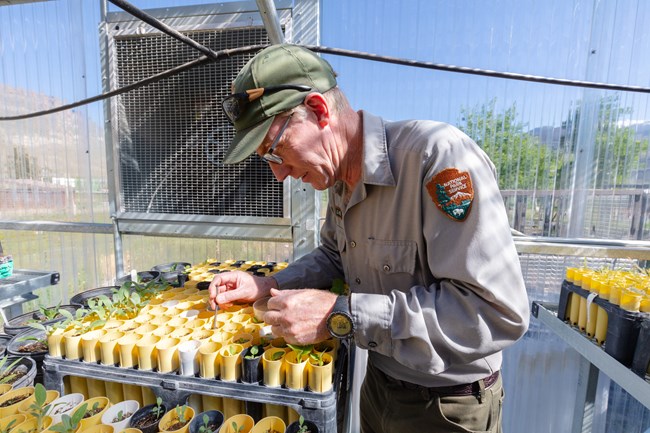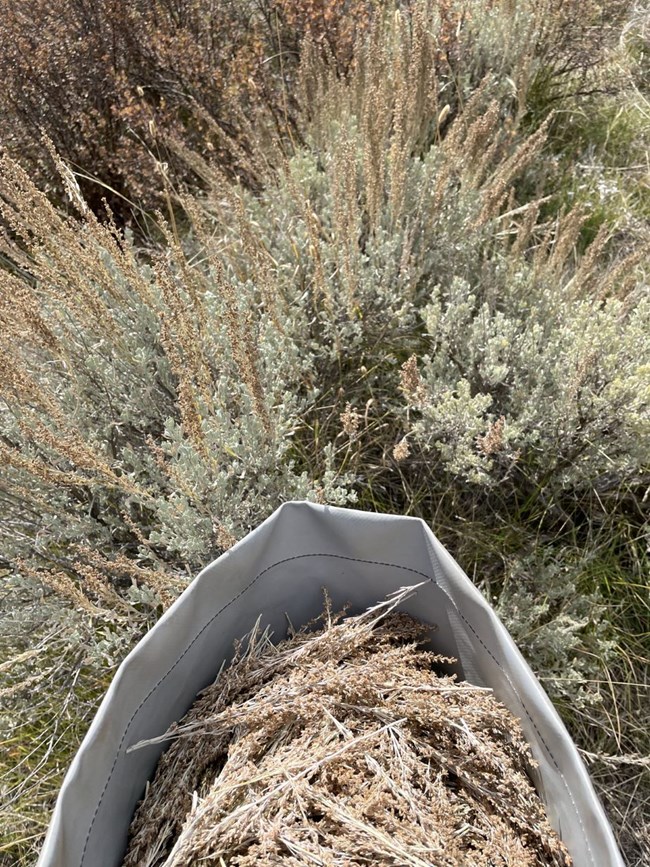Last updated: December 18, 2024
Article
Bipartisan Infrastructure Law powers growth of native seed stocks for landscape restoration
New strategy changes project level approach to whole ecosystem restoration
Severe wildfires and extreme climate events often devastate healthy ecosystems in parks and on other public lands. Yet when the fires pass, when flood waters recede, there isn’t enough genetically appropriate native seed available to restore these landscapes.
That situation is changing with coordinated projects among the National Park Service (NPS) and other Department of the Interior agencies, the US Forest Service and wide-ranging partnerships with other public entities and private companies. The agencies – 12 in all – work together under a National Seed Strategy to identify native seed needs, build enduring native seed capacity, and advance interagency and partner ecoregional collaboration. Much of the work, and the increased pace of the work, is made possible with funds from the Bipartisan Infrastructure Law.
“We have many wonderful projects funded by the infrastructure law that address serious threats from fire and invasive plants, but there is more,” said Lori Makarick, ecosystem restoration coordinator for the National Park Service. “The infrastructure law actually helps us move from a project-by-project focus to truly restoring entire ecosystems.”

Cover image by the Plant Conservation Alliance
In the past, before the infrastructure law intersected with the National Seed Strategy which fosters interagency collaboration, the bulk of landscape restoration and revegetation work in parks and on other public lands occurred as part of individual construction projects, in response to disastrous weather events in a specific area, in response to fire, usually in smaller areas that affected a single park or part of a national forest, and in one-off projects to manage invasive plant populations.
Projects seemed to be on figurative islands – of parks within the NPS, of other public lands managed by other Interior agencies like the Bureau of Land Management, the US Fish and Wildlife Service, the Bureau of Reclamation, on lands managed by the Forest Service. There was a feeling among restoration specialists of never quite catching up. And there was always a concern over the lack of locally appropriate, native seed stocks.
Makarick said few U.S. native plant species are available commercially in the quantity, diversity, and quality necessary to restore resilient habitats. In most areas of the country, native plants and seeds of local origin are rarely available. It is vitally important for federal land management agencies to work together to meet nationwide revegetation and restoration needs to ensure we have healthy and productive native plant communities in America’s iconic landscapes.
"We have a vision with the National Seed Strategy. We want to get the right seed in the right place at the right time. It’s kind of our refrain." said Katie VinZant, an NPS restoration ecologist and coordinator for NPS native seed projects funded by the infrastructure law. “The infrastructure law is a game changer. We benefit from financial resources and from the direction for coordinated efforts between federal agencies and involvement with partners and private companies.”

NPS/Jacob W. Frank
What is locally appropriate or genetically appropriate native seed? And how much is needed?
Local native seed comes from native plant communities that have, over time, adapted to elevation, weather, soil type and other characteristics. Native plant communities are crucial for maintaining biodiversity, as they provide key ecosystem functions such as conservation of water, erosion protection, and habitat and forage for wildlife.
Using locally sourced seed for restoration efforts is important not only for maintaining genetic diversity, but also to best ensure restoration success. However, harvesting seed from native plant communities repeatedly or in large quantities can hurt those communities and the other plants and wildlife that depend on them. “With the amounts of seed we need – and we need massive amounts – we have to change,” VinZant said. “We’re moving towards harvesting small amounts of seed from the parks and planting that seed in a more crop-like setting where seed can then be harvested in greater quantities. We have dozens of large projects involving multiple parks and regions in the coming years and that’s just the National Park Service. The infrastructure law also encourages collaboration with other agencies in the Department of the Interior and the US Forest Service and they also have large scale native seed needs.”
Native plant seeds are produced by a small segment of the commercial seed industry. This group has specialized knowledge and the equipment, but each batch of seed requires several years of lead time for production. The ability of restoration specialists to work across ecoregions and agencies will help smooth out the volatility of demand and reduce the uncertainty in the market for native seed and seed producers. “Our changing climate means we will continue to have extreme weather events, fire, and invasive plant species batter already degraded ecosystems,” VinZant said. “The infrastructure law combined with the National Seed Strategy helps us to keep commercial growers engaged in the production of seed we need now and in the future.”
From 2022 to 2024, the National Park Service has invested nearly $3 million from the infrastructure law in projects to increase native seed capacity. The next steps, under the infrastructure law, are to implement restoration actions for the benefit of healthy ecosystems.
Ecosystem restoration is key to meeting the NPS mission to conserve natural and cultural resources and for the enjoyment, education, and inspiration of this and future generations. Healthy ecosystems benefit people, animals, plants, and their shared environment which includes parks. Healthy ecosystems bolster our ability to mitigate and adapt to the effects of our changing climate.

NPS Photo
Projects have multiple partnerships and include:
-
Restoration of federally threatened whitebark pines at national parks in Washington, Montana, and Wyoming. These projects have a variety of tactics to diminish threats from plant disease, beetle infestation, changing fire regimes and climate change. Unchecked these threats will cause irreversible losses of the trees and their capacity to slow annual snowmelt to check erosion, as well as food for many wildlife species including the threatened grizzly bear.
-
Building in-house and partner capacity to scale up collection, production, and storage of native seeds with a focus on ’workhorse’ species to meet restoration and revegetation needs.
-
Increasing seed capacity and use of native vegetation throughout Alaska, especially on riparian areas around salmon habitat and hazard mine sites. This project features the National Park Service and the new Alaska Native Plant Materials Working Group.
-
Seed collection and increased plant propagation capacity at Wind Cave National Park and at Sleeping Bear Dunes National Lakeshore through collaboration with the Intertribal Buffalo Council/Buffalo Seedkeepers and Chicago Botanical Garden, respectively.
-
Converting agricultural acreages to native grasslands in Appalachian Mountains parks in Virginia, Maryland, and Pennsylvania to increase the ecological and cultural value of the parks.
-
Conversion of 500 acres of degraded rangeland to short grass prairie and sage shrubland at Sand Creek Massacre National Historic Site in Colorado. The park is working with the Northern Cheyenne, Northern Arapaho, and Cheyenne and Arapaho tribes, and Colorado Parks and Wildlife.
